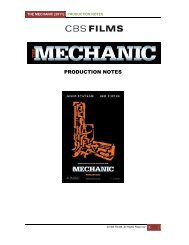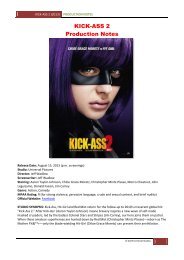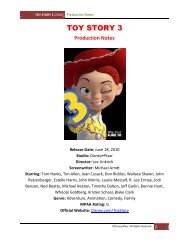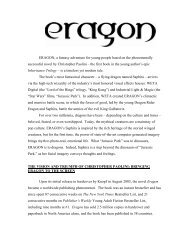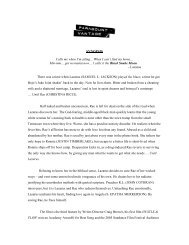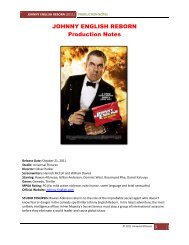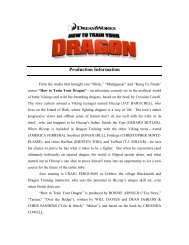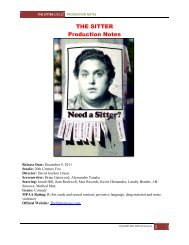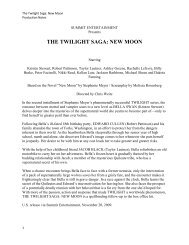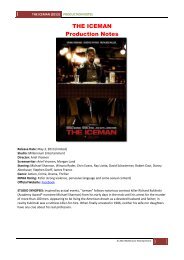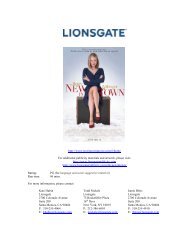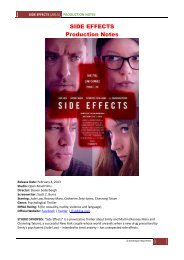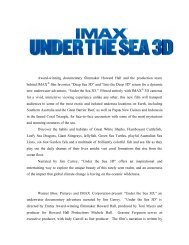"Cloud Atlas" production notes [PDF] - VisualHollywood
"Cloud Atlas" production notes [PDF] - VisualHollywood
"Cloud Atlas" production notes [PDF] - VisualHollywood
You also want an ePaper? Increase the reach of your titles
YUMPU automatically turns print PDFs into web optimized ePapers that Google loves.
CLOUD ATLAS (2012) PRODUCTION NOTES<br />
later, the city's famous Walter Scott Monument served as his retreat and the place where he last sees<br />
the love of his life. The 200-foot monument, heretofore never closed to the public for filming,<br />
granted "<strong>Cloud</strong> Atlas" two days' access so cameras and equipment could be hoisted up to the viewing<br />
platform by crane rather than via its narrow spiral staircase.<br />
For Ayrs' stately manor where Frobisher seeks employment, Tykwer and <strong>production</strong> designer Uli<br />
Hanisch joined the locations team in scouting the Scottish countryside to find the privately owned<br />
Overtoun House in West Dunbartonshire. It would serve not only as Ayrs' home in 1936, but appear<br />
re-dressed as the nightmarish Aurora Country Estates where Cavendish is incarcerated in 2012.<br />
"We have nearly 80 years between them so the trees and garden would be different. The strategy<br />
was to add things like foliage for the earlier time that we could then remove for the plainer exterior,<br />
decades later," <strong>notes</strong> Hanisch. To further suit the Cavendish scenes they added a conservatory and a<br />
formidable front gate.<br />
Symbolically, Tykwer suggests, "It was once the chateau where Ayrs, the elderly composer, tries to<br />
imprison young Frobisher, and then a lifetime later it's him, reborn as Cavendish, who finds himself<br />
imprisoned in the place where he used to be the warden."<br />
It was determined in the film's conceptual stages that certain spaces should likewise be repeated<br />
from one part of the story to another. "We wanted to be flexible, however," states Hanisch. "Sometimes<br />
it's the real place, sometimes just a hint. Our starting point was Ewing's cabin under the deck<br />
of the ship, and we recreated the shape of this room throughout: Cavendish's office, Luisa Rey's<br />
apartment, Frobisher's room in Ayrs' mansion, Sonmi's safe house and Zachry's hut."<br />
Thus, the interior of Ayrs' opulent musical salon, built on a soundstage, became the Aurora Country<br />
Estates' depressing dining room. The restaurant where Sonmi works, which Bateup designed, boasts<br />
a cheerful, brightly lit, virtual atmosphere for consumers to enjoy, but after-hours reveals its grey<br />
cavernous reality. "We had to invent a consumer society of 2144 and imagine what a fast-food restaurant<br />
would look like. Lana and Andy have definite ideas about how they see these periods so we<br />
tossed around ideas and eventually came up with the Sonmi world," he says. After filming wrapped<br />
for those scenes, the space was repurposed in black, white and red as the rooftop venue for Cavendish's<br />
book reception, where a massive aquarium pays homage to the virtual fish pond of the restaurant's<br />
floor.<br />
The designers also established reappearing elements such as trains and bridges that figure in Frobisher's,<br />
Cavendish's, Luisa Rey's and Zachry's storylines. Egg-shaped objects also recur, from the<br />
toys in the factory that Luisa Rey runs through in San Francisco to the restaurant seats and the recording<br />
device of Sonmi's archivist.<br />
"We wanted our depictions of each era to be clear so there's no question whether it's the 1930s or<br />
the 1840s," says Hanisch. "At the same time, visual cues and recycled spaces reinforce the idea of<br />
connections and the continuity of a single story."<br />
Also responsible for the film's lush and seamless look were cinematographers John Toll and Frank<br />
Griebe. "The principal visual design elements were in place when we came onto the film," <strong>notes</strong><br />
Toll. "One major goal of the cinematography was to blend the look of the individual sequences that<br />
spanned 500 years to create an overlapping and rich dramatic feel for the entire story, but not necessarily<br />
by trying to create one specific and detailed look for the whole film. Basically, this meant a<br />
visual approach that was appropriate to each chapter while still maintaining a sense of continuity<br />
throughout."<br />
© 2012 Warner Bros. Pictures 16


!["Cloud Atlas" production notes [PDF] - VisualHollywood](https://img.yumpu.com/7420477/16/500x640/quotcloud-atlasquot-production-notes-pdf-visualhollywood.jpg)
